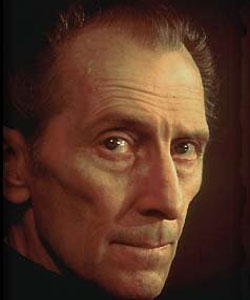
.
.

.
.
The list of the Doctors is not complete without the addition of Richard Hurndall in the role of the First Doctor, after the death of William Hartnell, in the special 90 minute twentieth anniversary of the series in the episode 'The Five Doctors' airing November 1983.
John Nathan-Turner, the current Doctor Who producer,felt that Richard bore a striking resemblance to William Hartnell, which was a major factor in his selection for the role.
The careers of both Hurndall and Hartnell bear striking similarities, although Richard did not have so difficult a childhood. He was born two years later than William Hartnell, on November 3, 1910, in Darlington, Co. Durham. After graduating Scarborough College he made the decision to begin an acting career and enrolled in RADA (Royal Academy for Dramatic Arts).
He made his first stage appearance in the production A Pantomime Rehearsal playing a footman, in December 1930. Following this Richard made several appearances in various repertory productions. Like William Hartnell an important part of his early career was appearing in Charley's Aunt (1937) where he played Lord Fancourt Babberley.
Again like Hartnell he the gained experience playing in several Shakespearian roles including the part of Bassanio, in The Merchant of Venice and as Laertes in Hamlet. After his war service, he continued his stage work, building up his reputation playing legal roles such as Sir Peter Crossman in Hostile Witness (1964). Film role followed with appearances in Zeppelin and Royal Flash, as well as on radio and Television in Enemy at The Door and Nanny. Richard's interest of Genealogy seemed an interesting coincidence in playing the part of a Time Lord.
Sadly Richard died April 13, 1984.


.
.
Born in Kent on May 26, 1913. After graduating school Peter started an office job in the Coulsdon and Purley Urban District Council. Following his desire to act he finally broke into the world of repertory theatre, in 1936, first as an assistant stage manager, then to acting.
In 1939, after having performed for a few years in various theatres around, England he moved to Hollywood, . His first part was to double for Louis Heyward in The Man in the Iron Mask (1939). then cast as a Lieutenant in They Dare Not Love (1941).
In between those two films, he played as a student in Laurel and Hardy's A Chump at Oxford (1939). But the war eventually put a temporary halt to acting. Turned down by the military on medical grounds, he returned to England in 1941 to serve with ENSA. It was there that he met his future wife, Helen Beck.
After the war he returned to theatre work and had a few small roles in films, the most notable of these being Osric in Olivier's Hamlet (1948). In the early 1950s his career finally took off, thanks to television, appearing in Rudolph Cartier's seminal production of 1984 (1954), and in films, Pride and Prejudice (as Mr. Darcy), Beau Brummell, The Browning Version, and Nigel Kneale's The Creature.
In 1956 he had his first starring role in a feature film, the successful The Curse of Frankenstein (1957). His television appearances would continue throughout the '60s, but generally in smaller parts than his '50s roles. An exception was the BBC series The Adventures of Sherlock Holmes (1969), playing the great detective.
He appeared in about thirty films during the '60s. His horror films during this decade included three more outings as Baron Frankenstein (four if you include Jerry Lewis's comedy One More Time (1969)), The Gorgon, and The Blood Beast Terror. During this period he made almost as many films for Milton Subotsky as he did for Hammer including Dr Terror's House of Horrors (1964), Torture Garden (1967), and Scream and Scream Again (1969).
The early 70's would prove to be the most prolific period of his career, highlights including Tales From the Crypt (1972), Fear in the Night (1972), Horror Express (1972), Frankenstein and the Monster From Hell (1973), From Beyond the Grave (1974), The Beast Must Die (1974), and At the Earth's Core (1976).
He also appeared in Star Wars as Grand Moff Tarkin, but having been killed off was unable to appear in the sequels. A couple of cameos followed, first in Top Secret! (1984), and then, Biggles (1986).
This turned out to be his last film appearance, as Peter sadly died of cancer August 11, 1994


